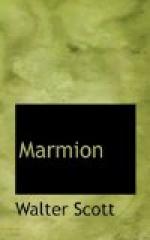Sir Thomas Malory’s ‘Morte D’Arthure’ was first printed by Caxton in 4to., 1485. A new issue of this belongs to 1634. The republication referred to by Scott is probably the edition published in 1816, in two vols. l8mo. The Roxburghe Club made a sumptuous reprint in 1819, and Thomas Wright, in 1858, edited the work in three handy 8vo. vols. from the text of 1634. This edition is furnished with a very useful introduction and notes.
lines 267-70. ’One day when Arthur was holding a high feast with his Knights of the Round Table, the Sangreal, or vessel out of which the last passover was eaten, (a precious relic, which had long remained concealed from human eyes, because of the sins of the land,) suddenly appeared to him and all his chivalry. The consequence of this vision was, that all the knights took on them a solemn vow to seek the Sangreal. But, alas! it could only be revealed to a knight at once accomplished in earthly chivalry, and pure and guiltless of evil conversation. All Sir Launcelot’s noble accomplishments were therefore rendered vain by his guilty intrigue with Queen Guenever, or Ganore; and in this holy quest he encountered only such disgraceful disasters as that which follows:—
’But Sir Launcelot rode overthwart and endlong in a wild forest, and held no path, but as wild adventure led him; and at the last, he came unto a stone crosse, which departed two wayes, in wast land; and, by the crosse, was a stone that was of marble; but it was so dark, that Sir Launcelot might not well know what it was. Then Sir Launcelot looked by him, and saw an old chappell, and there he wend to have found people. And so Sir Launcelot tied his horse to a tree, and there he put off his shield, and hung it upon a tree, and then hee went unto the chappell doore, and found it wasted and broken. And within he found a faire altar, full richly arrayed with cloth of silk, and there stood a faire candlestick, which beare six great candles, and the candlesticke was of silver. And when Sir Launcelot saw this light, hee had a great will for to enter into the chappell, but he could find no place where hee might enter. Then was he passing heavie and dismaied. Then he returned, and came again to his horse, and tooke off his saddle and his bridle, and let him pasture, and unlaced his helme, and ungirded his sword, and laid him downe to sleepe upon his shield, before the crosse.




